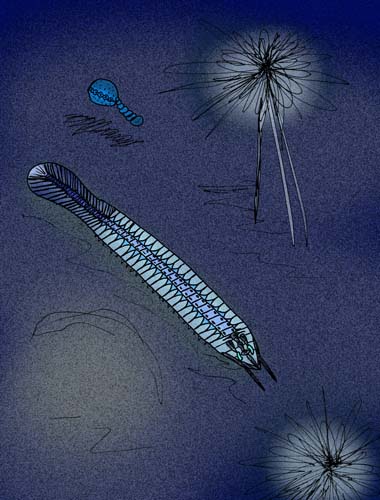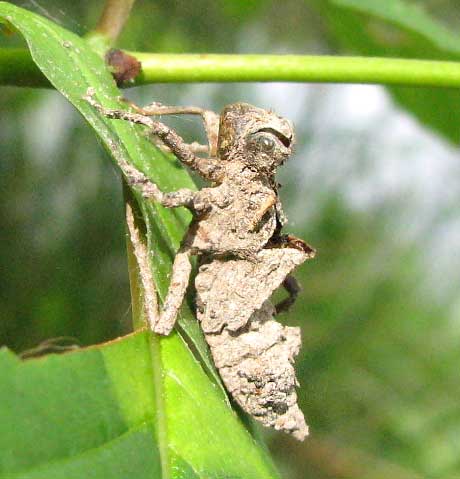|
Buenaspis
''Buenaspis'' is a genus of small ( long) nektaspid arthropod, that lived during the early Cambrian period.Budd, G.E (1999).A Nectaspid Arthropod from the Early Cambrian Sirius Passet Fauna, with a description of Retrodeformation based on Functional Morphology. ''Palaeontology'', 42(1):99–122 Fossil remains of ''Buenaspis'' were collected from the Lower Cambrian Sirius Passet '' Lagerstätte'' of North Greenland. ''Buenaspis'' looks like a soft eyeless trilobite. It has a headshield (or cephalon) slightly larger than the tailshield ( pygidium), and in between them six thoracic body segments ( somites). The genus is monotypic, its sole species being ''Buenaspis forteyi''. Etymology The name of the genus is derived from the Buen Formation, the deposit where the species was collected, and the Greek word ''aspis'' (shield). The species was named in honor of Richard Fortey, a famed paleontologist. Description ''Buenaspis forteyi'' is between 1 and 3 cm along ... [...More Info...] [...Related Items...] OR: [Wikipedia] [Google] [Baidu] |
Buen Formation
The Buen Formation is a geologic formation and Lagerstätte in Peary Land, North Greenland. The shale preserves fossils dating back to the Early Cambrian period (Atdabanian in the local timescale, about 520 to 513 Ma).Buen Formation at .org Description The oldest Cambrian series of the area was deposited in the and is poorly exposed in fragmentary, heavily metamorphosed outcrops in |
Nektaspida
Nektaspida (also called Naraoiida, Nektaspia and Nectaspida) is an extinct order of non- mineralised artiopodan arthropods. They are known from the mid-Cambrian to the upper Silurian. Originally classified as trilobites, which they superficially resemble, they are now placed as close relatives as members of the Trilobitomorpha within Artiopoda. The order is divided into three major families; Emucarididae, Liwiidae, and Naraoiidae. Naming history and taxonomic placement The order was originally proposed by Raymond in 1920 as Nektaspia. Størmer corrected it to Nectaspida for the 1959 ''Treatise on Invertebrate Paleontology'' to conform with the names of the other trilobite orders. Whittington described it in 1985 with the spelling Nektaspida; the revised 1997 Treatise by Raymond and Fortey uses this spelling, as do other modern works. Whittington (1985) placed the order in the Trilobita. Cotton & Braddy (2000) place it in a new "Trilobite clade" containing the Trilobita, recog ... [...More Info...] [...Related Items...] OR: [Wikipedia] [Google] [Baidu] |
Sirius Passet
Sirius Passet is a Cambrian Lagerstätte in Peary Land, Greenland. The Sirius Passet Lagerstätte was named after the Sirius sledge patrol that operates in North Greenland. It comprises six places in Nansen Land, on the east shore of J.P. Koch Fjord in the far north of Greenland. It was discovered in 1984 by A. Higgins of the Geological Survey of Greenland. A preliminary account was published by Simon Conway Morris and others in 1987 and expeditions led by J. S. Peel and Conway Morris have returned to the site several times between 1989 and the present. A field collection of perhaps 10,000 fossil specimens has been amassed. It is a part of the Buen Formation. Age The fauna is inevitably compared to that of the Burgess Shale, although it is probably ten to fifteen million years older – vs. ) – and more closely contemporaneous with the fauna of the Maotianshan shales from Chengjiang, which are dated to . Preservation The preservation of the Sirius Passet is traditiona ... [...More Info...] [...Related Items...] OR: [Wikipedia] [Google] [Baidu] |
Soomaspis Splendida
''Soomaspis'' is a genus of small to average size (about 3 cm or 1.2-inch long) marine arthropods in the Liwiidae Family, that lived during the late Ordovician (early Hirnantian). Fossil remains of ''Soomaspis'' were collected from the Soom Shale Lagerstätte in Western Cape, South Africa. ''Soomaspis'' looks like a large, soft agnostid trilobite. It has a headshield (or cephalon) wider than the tailshield (pygidium), and in between them three thoracic body segments (somites). The genus is monotypic, its sole species being ''Soomaspis splendida''. Etymology The name of the genus is a compound word of the deposit where the species was collected (the Soom Shale), and the Greek word ''"aspis"'' (shield). The species epithet, ''splendida'' comes from the Latin word ''"splendere"'' (brightness). Description ''Soomaspis splendida'' is estimated to be over 3 cm (1.2 inches) along the axis,L. Ramskold, J.-Y. Chen, G.D. Edgecombe, and G.-Q. Zhou (1996). "Preservational fo ... [...More Info...] [...Related Items...] OR: [Wikipedia] [Google] [Baidu] |
Tariccoia
''Tariccoia'' is a genus of nektaspid arthropods belonging to the family Liwiidae, known from fossils found in Ordovician strata in Sardinia and Morocco. It is between and long. It has a headshield (or cephalon) wider than the tailshield (pygidium), and in between them three (or four?) thoracic body segments (somites). Etymology The name of the genus references the Sardinian paleontologist M. Taricco. The species was named after the Riu is Arrus Member, the deposit in which it was found. Description ''Tariccoia arrusensis'' is between 2.5 and 6 cm along the axis, almost half a wide as long. The dorsal exoskeleton consists of a cephalon, a pygidium and two or three thoracic somites with articulating half-rings, all non-calcified. The cephalon is sub-semicircular, widest near the rounded genal angles. The cephalon is wider than the pygidium. Eyes are absent. Antennas are not known. The body is constricted at the two or three thoracic somites, so the animal gives the im ... [...More Info...] [...Related Items...] OR: [Wikipedia] [Google] [Baidu] |
Lamellipedia
Lamellipedia is a proposed clade of arthropods that includes most trilobites (but not Agnostida) and their close relatives. Distinctive of the clade are the flat setae aligned in a comb-like structure on the exopod The arthropod leg is a form of jointed appendage of arthropods, usually used for walking. Many of the terms used for arthropod leg segments (called podomeres) are of Latin origin, and may be confused with terms for bones: ''coxa'' (meaning hip, plur .... References Arthropod taxonomy {{paleo-arthropod-stub ... [...More Info...] [...Related Items...] OR: [Wikipedia] [Google] [Baidu] |
Richard Fortey
Richard Alan Fortey FRS FRSL (born 15 February 1946 in London) is a British palaeontologist, natural historian, writer and television presenter, who served as president of the Geological Society of London for its bicentennial year of 2007. Early life and education Fortey was educated at Ealing Grammar School for Boys and King's College, Cambridge, where he read Natural Sciences specialising in geology. He received a PhD and DSc from the University of Cambridge. Career Fortey has had a long career as a palaeontologist at the Natural History Museum in London; his research interests include above all, trilobites: at the age of 14, he discovered his first trilobite, sparking a passionate interest that later became a career. He has named numerous trilobite species and still continues his research despite having retired from the Museum. He studies trilobites and graptolites, especially those from the Ordovician and their systematics, evolution and modes of life; he is also involved ... [...More Info...] [...Related Items...] OR: [Wikipedia] [Google] [Baidu] |
Dorsal (anatomy)
Standard anatomical terms of location are used to unambiguously describe the anatomy of animals, including humans. The terms, typically derived from Latin or Greek roots, describe something in its standard anatomical position. This position provides a definition of what is at the front ("anterior"), behind ("posterior") and so on. As part of defining and describing terms, the body is described through the use of anatomical planes and anatomical axes. The meaning of terms that are used can change depending on whether an organism is bipedal or quadrupedal. Additionally, for some animals such as invertebrates, some terms may not have any meaning at all; for example, an animal that is radially symmetrical will have no anterior surface, but can still have a description that a part is close to the middle ("proximal") or further from the middle ("distal"). International organisations have determined vocabularies that are often used as standard vocabularies for subdisciplines of ana ... [...More Info...] [...Related Items...] OR: [Wikipedia] [Google] [Baidu] |
Exoskeleton
An exoskeleton (from Greek ''éxō'' "outer" and ''skeletós'' "skeleton") is an external skeleton that supports and protects an animal's body, in contrast to an internal skeleton ( endoskeleton) in for example, a human. In usage, some of the larger kinds of exoskeletons are known as " shells". Examples of exoskeletons within animals include the arthropod exoskeleton shared by chelicerates, myriapods, crustaceans, and insects, as well as the shell of certain sponges and the mollusc shell shared by snails, clams, tusk shells, chitons and nautilus. Some animals, such as the turtle, have both an endoskeleton and an exoskeleton. Role Exoskeletons contain rigid and resistant components that fulfill a set of functional roles in many animals including protection, excretion, sensing, support, feeding and acting as a barrier against desiccation in terrestrial organisms. Exoskeletons have a role in defense from pests and predators, support and in providing an attachment framewo ... [...More Info...] [...Related Items...] OR: [Wikipedia] [Google] [Baidu] |
Liwia
''Liwia'' is a genus of nektaspid, a soft-bodied stem-group chelicerate. It includes the following species, both are known from borehole samples several kilometers in depth from the Zawiszyn Formation in Poland, which has also yielded ''Peytoia infercambriensis ''Peytoia infercambriensis'' is a species of hurdiid radiodont in the genus ''Peytoia''. ''P. infercambriensis'' is the geologically oldest known radiodont; its remains date to the third age of the Cambrian. The type and only known specimen, ....'' *''Liwia plana'' Lendzion, 1975 *''Liwia convexa'' Lendzion 1975 References Nektaspida Fossils of Poland {{nektaspida-stub ... [...More Info...] [...Related Items...] OR: [Wikipedia] [Google] [Baidu] |
Atdabanian
Cambrian Stage 3 is the still unnamed third stage of the Cambrian. It succeeds Cambrian Stage 2 and precedes Cambrian Stage 4, although neither its base nor top have been formally defined. The plan is for its lower boundary to correspond approximately to the first appearance of trilobites, about million years ago, though the globally asynchronous appearance of trilobites warrants the use of a separate, globally synchronous marker to define the base. The upper boundary and beginning of Cambrian Stage 4 is informally defined as the first appearance of the trilobite genera '' Olenellus'' or ''Redlichia'' around million years ago. Naming The International Commission on Stratigraphy has not officially named the 3rd stage of the Cambrian. The stage approximately corresponds to the "Atdabanian", which is used by geologists working in Siberia. Biostratigraphy The oldest trilobite known is '' Lemdadella'' which appears at the beginning of the ''Fallotaspis'' zone. The Cambrian rad ... [...More Info...] [...Related Items...] OR: [Wikipedia] [Google] [Baidu] |
Liwiidae
Liwiidae is a family of arthropods in the order Nektaspida. Members are known from the Cambrian and Ordovician periods. Taxonomy *''Liwia'' Dzik and Lendzion, 1988 :*''Liwia plana'' Lendzion, 1975 :*''Liwia convexa'' Lendzion, 1975 *''Soomaspis'' Fortey & Theron, 1995 :*''Soomaspis splendida'' Fortey & Theron, 1995 *''Tariccoia'' Hammann ''et al.'', 1990 :*''Tariccoia arrusensis ''Tariccoia'' is a genus of nektaspid arthropods belonging to the family Liwiidae, known from fossils found in Ordovician strata in Sardinia and Morocco. It is between and long. It has a headshield (or cephalon) wider than the tailshield (pygi ...'' Hammann ''et al.'', 1990 References Nektaspida Prehistoric arthropod families Cambrian first appearances Ordovician first appearances {{nektaspida-stub ... [...More Info...] [...Related Items...] OR: [Wikipedia] [Google] [Baidu] |





